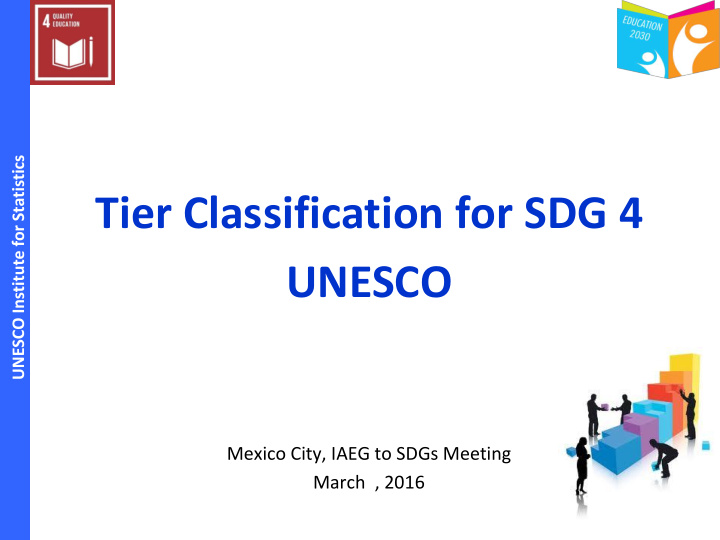



UNESCO Institute for Statistics Tier Classification for SDG 4 UNESCO Mexico City, IAEG to SDGs Meeting March , 2016 1
Criteria for TIER Classification UNESCO Institute for Statistics Tier 1 conceptually clear, established methodology and standards Available but data is produced regularly by countries Tier 2 conceptually clear, established methodology and standards Available but data is not produced regularly by countries Tier 3: Indicators for which there are no standard and methodology are being developed/tested
Why SDG 4.1. is TIER I and II? SDG 4.1. has 3 points of measurement: i) grades 2/3; UNESCO Institute for Statistics End of Primary; and iii) End of Lower High School Encompasses National Learning Assessments, Cross National Assessment of regional and Global Coverage at different level of education. Involved various initiatives and agencies depending on the Level. Each point of measurement has different “coverage” and agreed standards with End of Primary and End of Lower HS 3
4.1. all assessment # of countries with assessments # of UNESCO Institute for Statistics # of countries countries with at % of Region with no Total # least 1 region assessments Cross - assessment National Regional national East Asia and Pacific 22 14 14 8 32 40 90 Europe and Central Asia 41 0 46 9 28 57 84 Latin America and Caribbean 26 18 17 14 27 41 66 Middle East and North Africa 3 0 2 1 3 4 75 South Asia 8 0 1 0 8 8 100 Sub-Saharan Africa 30 27 3 11 37 48 77 TOTAL 146 59 101 47 173 220 79 4
Cross National Initiatives UNESCO Institute for Statistics Name Name description PIRLS Progress in International Reading Literacy Studies TIMSS Trend in International Mathematics and Science Studies PISA Programme for International Student Assessment Laboratorio Latinoamericano de Evaluación de la Calidad de la Educación TERCE (LLECE) SACMEQ Southern and Eastern Africa Consortium for Monitoring Educational Quality PASEC CONFEMEN Programme for the Analysis of Education Systems PILNA Pacific Island Literacy and Numeracy Assessment 5
Cross National Assessments Grade Assessment # of countries Reading Numeracy and mathematics UNESCO Institute for Statistics PASEC 10 X X 2 TERCE 15 X X 3 PRILS 48 X PILNA 13 X X 4 TIMSS 63 X N/A N/A N/A N/A 5 TERCE 15 X X PASEC 10 X X 6 PILNA 13 X X SACMEQ 15 X X N/A N/A N/A N/A 7 TIMSS 63 X 8 PISA (15-year olds) 65 X X 9 or 10 6
4.1. UNESCO TIER PROPOSAL 4.1.1: UNESCO Institute for Statistics TIER 1: End of Primary and End of Lower Secondary Wide coverage and the existence of agreed methodologies and initiatives Early grades (2/3) assessment could be considered in Tier II. 7
4.5.1 Parity Indices The fact that we can not disaggregate for all UNESCO Institute for Statistics categories is the only problem in this case Disaggregation in some cases is already public and available (e.g. Gender) The problem is data collection not methodology and once collected the estimate of indicator is simple does not need any harmonization criteria. Not all indicators need disaggregation 8
4.7.1 and 12.8.1 GCED Methodology is based on national reporting on UNESCO Institute for Statistics progress towards a UNESCO convention A revised reporting template will be submitted to UNESCO EB and once approved, countries will begin submitting their reports Tier II seems to be the right classification Methodology of data collection and reporting indicators again is simple GCED Level National policy Teachers curriculu Curriculum NLA NLA Primary HS 9
Education 2030 Technical Coordinating Group Builds on the work of the Technical Advisory Group UNESCO Institute for Statistics which developed the proposals for the thematic and global indicators for monitoring SDG4 Has mandate to advise on implementation and to map capacity building and financial needs, and the methodological development of indicators UIS/UNICEF/World Bank and OECD are launching on April 5th an Interagency group on disaggregated indicators in education to ensure harmonization of standards and methodologies for equity. 10
UNESCO Institute for Statistics Thank you! UNESCO Institute for Statistics @UNESCOstat 11
Recommend
More recommend